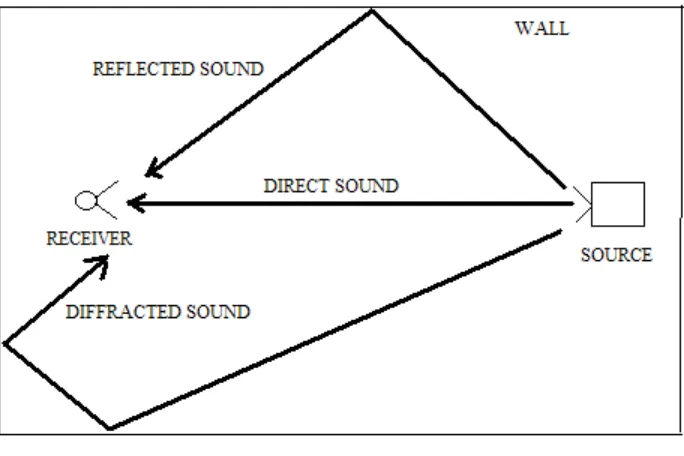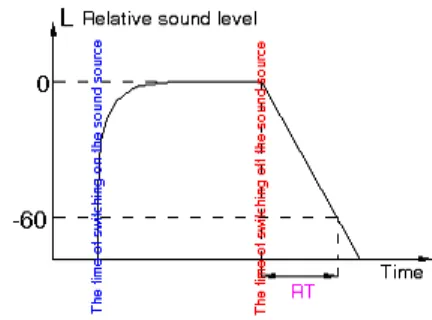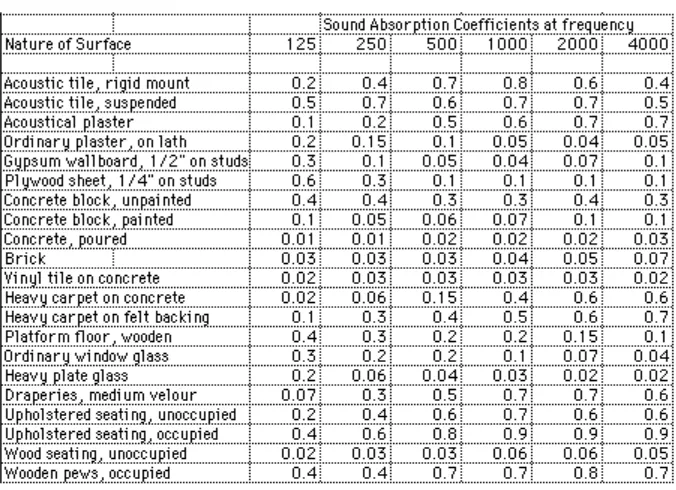MEASUREMENT AND EVALUATION OF THE REVERBERATION TIME FOR CLASSROOMS IN UTEM
AIZAT MOHAMED ALI
This report is to fulfill the course evaluation In
Bachelor’s Degree of Mechanical Engineering (Automotive)
Fakulti Kejuruteraan Mekanikal Universiti Teknikal Malaysia Melaka
AIZAT BIN MOHAMED ALI
i
I declare that this thesis entitled “Measurement and Evaluation of Reverberation Time for Classrooms in UTEM ” is the result of my own research except as cited in the
references.
Signature :
ABSTRACT
iii
ABSTRAK
ACKNOWLEDGEMENT
v
TABLE OF CONTENTS
DECLARATION i
ABSTRACT ii
ABSTRAK iii
ACKNOWLEDGEMENT iv
TABLE OF CONTENTS v
LIST OF TABLE viii
LIST OF FIGURE ix
CHAPTER 1: INTRODUCTION
1.1 Project Introduction 1
1.2 Problem Statement 2
1.3 Project Objective 3
1.4 Project Scope 3
1.5 Report Structure 4
CHAPTER 2: LITERATURE REVIEW
2.1 Reverberation Time 7
2.1.1 Rationale for 60 db Reverberation Time 9
2.2 Speech Intelligibility 10
2.3 A-weighted Curve 12
2.4 Background Noise Level 13
2.5 Sound Propagation 14
2.5.1 Direct Sound 14
2.5.2 Reflection 14
2.5.3 Diffraction 14
2.6 The Sabine Equation 16
2.7 Absorption Coefficient 17
2.8 ANSI S12.60-2002 19
CHAPTER 3: RESEARCH METHODOLOGY
3.1 Selecting Measurement Location 21
3.2 Reverberation Time by Calculation 23
3.3 Reverberation Time by Measurement 24
3.4 Experimental Setup 25
3.4.1 Omni directional Calibrated Microphone 26
3.4.2 Signal Conditioning 27
3.4.2.1 Pre-Amp 27
3.4.2.2 Analog-to-Digital Converter (ADC) 28 3.4.3 Data Acquisition System (DAQ) 29
vii
3.4.5 Experiment Procedure 31
CHAPTER 4: RESULTS AND DISCUSSION
4.1 Experiments Results 33
4.1.1 BK6 Results 33
4.1.2 BK10 Results 36
4.2 Calculation Results 42
4.2.1 BK6 Calculation 42
4.2.2 BK10 Calculation 43
4.3 Discussion 45
4.3.1 Problems Encountered 46
4.3.2 Implication of the Result 47
4.3.3 Recommendation 47
CHAPTER 5: CONCLUSION 48
LIST OF TABLE
TABLE TITLE PAGE
1 Absorption Coefficient of Materials 12
2 Maximum A-weighted steady background noise levels and maximum reverberation times in unoccupied,
furnished learning spaces 18
3 Recommended approximate heights 21
4 Interpolation Data for First Position in BK6 33
5 Interpolation Data for Second Position in BK6 34
6 Interpolation Data for Third Position in BK6 35
7 Interpolation Data for Fourth Position in BK6 36
8 Interpolation Data for First Position in BK10 38
9 Interpolation Data for Second Position in BK10 39
10 Interpolation Data for First Position in BK10 40
11 Interpolation Data for Fourth Position in BK10 41
12 Comparison Data between Measured, Calculated and
ix
LIST OF FIGURE
FIGURE TITLE PAGE
1 Sound Propagation 8
2 Relative Sound Level vs Time 10
3 SPL of Speech at 1 m 15
4 A-,B-,C- Weighting Functions 16
5 Experiment Setup Diagram 24
6 A sample of Omni Directional Microphone 25
7 A Sample of Pre-Amp 26
8 Sampling Rates 27
9 A sample of DAQ Device 28
10 Classroom Setup for BK6 31
11 Classroom Setup for BK10 31
12 Measured Data for First Position in BK6 33
13 Measured Data for Second Position in BK6 34
14 Measured Data for Third Position in BK6 35
15 Measured Data for Fourth Position in BK6 36
16 Measured Data for First Position in BK10 37
17 Measured Data for Second Position in BK10 38
18 Measured Data for Third Position in BK10 39
CHAPTER1
INTRODUCTION
1.1 Project Introduction
2
1.2 Problem Statement
Primarily, classrooms instruction is presented through the teacher’s speech or through video or tape recordings. According to the Signal to Noise Ratio (S/N), normal people will have +6dB S/N which mean the speech signal must be 6dB louder than the background disturbance in other for it to be understand. One way to improve the teaching and learning in class is that to increase the volume of the teacher’s voice over the background noise.
American Speech-Language-Hearing Association (ASHA) recommends that the teacher’s voice should be 15dB above the background noise in a classroom. From previous reports that have been studied, the actual range of S/N in a classroom is +5dB to +7dB. Unfortunately, the background noise, teacher’s location and reverberation could vary the range from -20dB to +5db. This poor listening environment due to S/N ratios could effect the student’s concentration.
UTEM whether it achieves the standard reverberation time for classrooms specified by ANSI S12.60-2002. The quality of teaching and learning in classrooms is important in order to achieve the UTEM’s vision which is to be one of the world’s leading innovative and creative technical universities. Besides that, the purpose of this project is to suggest improvements that need to be made to the classrooms.
1.4 Project Scope
4
1.5 Report Structure
Chapter 1 covers the project objective and scope thoroughly. This includes the problem statements of the project on why does this project need to be carried out. The flow process of making this report is also explained in this chapter with the help of a gantt chart.
Chapter 2 elaborates more about the basic terms of acoustics such as definitions and other theory. This chapter will also explain in details about reverberation time definition, terms for reverberation time that need to be considered, ANSI S12.60-2002 standard and the formulas used in calculating reverberation time.
Chapter 3 presents the method in calculating and measuring the reverberation time, previous measurement method and the measurement equipments that will be used in this project.
Chapter 4 will provide the experiment findings, calculation and comparison between the measurements that have been done and ANSI S12.60-2002 standard. Also in this chapter, discussions have been made on problems encountered and recommendations in improving the reverberation time.
TITLE SELECTION
TITLE CONFIRMATION
OBJECTIVES & SCOPE
PROBLEM STATEMENT
LITERATURE REVIEW
METHODOLOGY
CONCLUSIONS
SUBMIT DRAFT REPORT
SUBMIT FULL REPORT
PSM 2 (January 2008 – March 2008)
ACTIVITIES
WEEK
1 2 3 4 5 6 7 8 9 10 11 12 13 14 15 16
LITERATURE REVIEW
MEASUREMENT
RESULT
ANALYSIS
DISCUSSION
CONCLUSIONS
SUBMIT DRAFT REPORT
SUBMIT FULL REPORT
CHAPTER 2
LITERATURE REVIEW
This chapter will provide the sound definition, the sounds characteristics, reverberation time and the international standards for reverberation time.
2.1 Sound Propagation
As sound spreads out in an enclosures, it meets obstacles: floor, ceiling, partitions (partial-height screens), light fixtures, furniture, etc. These obstacles change the path of the sound. When designing an open-plan room to block sound, designers must consider all of these paths. Figure 1 illustrates the possibility of sound propagates.
2.1.1 Direct Sound
Sound propagates outward in spheres. It spreads best when the line of sight is clear. Placing partitions between source and receiver blocks direct propagation paths.
2.1.2 Reflection
8
because some energy is absorbed into each surface. Some surfaces are more sound reflective than others. Sound absorbent surfaces can reduce reflected sounds in the room.
2.1.3 Diffraction
[image:19.612.175.517.305.533.2]Sound waves are able to bend over and around obstacles. However, the sound level attenuates as the sound waves bend. As the sharpness of the angle increases, the attenuation increases. For this reason, high, wide barriers block diffracted sound better than low, narrow barriers.
(called RT60). Reverberation time is defined for wide band signals. When talking about the decay of an individual frequency, the term decay time is used.
In the late 19th century, Wallace Clement Sabine started experiments at Harvard University to investigate the impact of absorption on the reverberation time (M. D. Egan, 1998). Using a portable wind chest and organ pipes as a sound source, a stopwatch and a clean pair of ears he measured the time from interruption of the source to inaudibility (roughly 60 dB). This time varies directly with the dimensions of room but inversely as the absorption present.
The best reverberation time for a space in which music is played depends on the size of the room and the type of music. Rooms for speech require a shorter reverberation time than for music. A longer reverberation time can make it difficult to understand speech. If the reverberation time from one syllable over laps the next syllable, it may make it difficult to identify the word "Cat", "Cab", and "Cap" may all sound very similar. If on the other hand the reverberation time is too short, tonal balance and loudness may suffer. Reverberation effects are often used in studios to "smooth" sounds; the effect is commonly used on vocals to help remove inconsistencies in pitch.
10
Figure 2: Relative Sound Level vs Time (Source: Roomacoustics.com (2005))
2.2.1 The Sabine Equation
Sabine's reverberation equation was developed in the late 1890s in an empirical fashion. He established a relationship between the RT60 of a room, its volume, and its total absorption (S. Bistafa and J. Bradly,2000). This is given by the equation:
RT60 = c · V (1)
Σ Sa
Where:
c = a mathematical constant measuring 0.161 V = the volume of the room in m3
S = total surface area of room in m2
shape or dimensions, nor losses from the sound travelling through the air (important in larger spaces). In general most rooms absorb less in the lower frequencies, causing a longer decay time.
2.2.2 Absorption Coefficient
The absorption coefficient of a material is a number between 0 and 1 which indicates the proportion of sound which is absorbed by the surface compared to the proportion which is reflected back into the room. A large, fully open window would offer no reflection as any sound reaching it would pass straight out and no sound would be reflected. This would have an absorption coefficient of 1. Conversely, a thick, smooth painted concrete ceiling would be the acoustic equivalent of a mirror, and would have an absorption coefficient very close to 0 (E. Sala and V. Viljanen, (1995).
12
Table 1: Absorption Coefficient of Materials (Source: hyperphysics.gsu.edu (2005))
2.2.3 Rationale for 60 dB Reverberation Time
The reverberation time is perceived as the time for the sound to die away after the sound source ceases, but that of course depends upon the intensity of the sound. To have a reproducible parameter to characterize an auditorium which is independent of the intensity of the test sound, it is necessary to define a standard reverberation time in terms of the drop in intensity from the original level, i.e., to define it in terms of relative intensity (D. J. MacKenzie, 1999).


